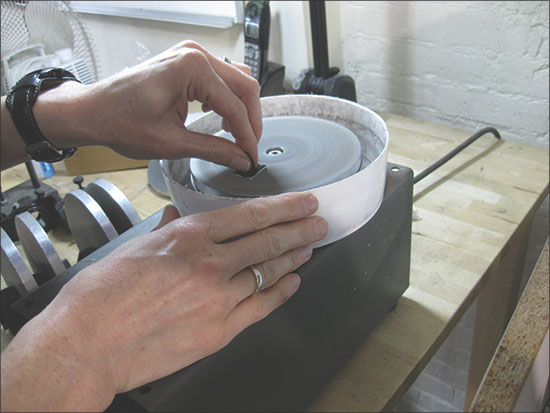Creative Uses for Duct Tape at the Bench
Ask any bench jeweler the best way to secure a band-aid to his or her cut finger during a day of working at the bench, and duct tape is bound to enter into the equation. Most jewelers have used duct tape to bind cuts and secure various pieces of equipment in the shop. The following are some other creative uses for this super strong tape at the bench.
2 Minute Read
Explore a jeweler's creative uses for duct tape at the bench. Duct tapes often are used for cuts, and hold an equipment together.
Ask any bench jeweler the best way to secure a band-aid to his or her cut finger during a day of working at the bench, and duct tape is bound to enter into the equation. Most jewelers have used duct tape to bind cuts and secure various pieces of equipment in the shop. The following are some other creative uses for this super strong tape at the bench.
Ann Cahoon of Flying Marquis Studio in Ashby, Massachusetts, uses duct tape to make holding jigs for sanding flat components. "Just take a strip, stick the center one-third or so to itself, and adhere the ends to the working piece," she says. "This creates a little handle that makes it a lot easier to hang onto things, especially when using a flat lap."
- When building hydraulic press dies, you may need to glue together several layers of Plexiglas to make a deep forming die. Run duct tape around the outer edge of the stack so that if it shatters during use, the pieces don't come flying out like shrapnel.
Fold a strip of duct tape over a drill bit or bur, fashioning a little propeller. This effectively blows away dust and debris when you are using the tool.
- Duct tape is great for holding sheet metal. You can secure a sheet to a flat anvil surface for chasing and using punches on it. Or, when working on a stake or anvil horn with a piece of sheet that is too small to hold with your fingers, use duct tape to hold it there while you hammer it to fit the curve.
- When gluing together stacks of plastic tubes that will be used to hold files or other tools, use duct tape to hold the tubes together while the glue sets. Follow the same procedure when gluing the tube stack beneath the surface of your bench top, removing the tape once the glue is dry.
- Jeff De Boer of Calgary, Alberta, Canada, uses duct tape for transferring complex 3-D surfaces to flat patterns — a trick he developed while making armor. Let's say you want to figure out the flat pattern of a piece of metal that will fit onto a shoulder or another unusual bowl-like shape. Make a pad about a quarter of an inch thick out of crumpled, crushed aluminum foil, and use a mallet to tighten the pad into a flexible blanket. Push the pad onto the shape you want to make in sheet metal, fitting the form, and then cover the outer surface of the pad in duct tape. Draw the outside shape boundaries on with a permanent market. Remove the pad, trim it with scissors to the line, and flatten it out. The flat shape is the pattern you'll need to cut out of the sheet metal to hammer and form the final fitted part.
The award-winning Journal is published monthly by MJSA, the trade association for professional jewelry makers, designers, and related suppliers. It offers design ideas, fabrication and production techniques, bench tips, business and marketing insights, and trend and technology updates—the information crucial for business success. “More than other publications, MJSA Journal is oriented toward people like me: those trying to earn a living by designing and making jewelry,” says Jim Binnion of James Binnion Metal Arts.
Click here to read our latest articles
Click here to get a FREE four-month trial subscription.
You assume all responsibility and risk for the use of the safety resources available on or through this web page. The International Gem Society LLC does not assume any liability for the materials, information and opinions provided on, or available through, this web page. No advice or information provided by this website shall create any warranty. Reliance on such advice, information or the content of this web page is solely at your own risk, including without limitation any safety guidelines, resources or precautions, or any other information related to safety that may be available on or through this web page. The International Gem Society LLC disclaims any liability for injury, death or damages resulting from the use thereof.
Charles Lewton-Brain
Master goldsmith Charles Lewton-Brain trained, studied and worked in Germany, Canada and the United States to learn the skills he uses. Charles Lewton-Brain is one of the original creators of Ganoksin.
The All-In-One Jewelry Making Solution At Your Fingertips
When you join the Ganoksin community, you get the tools you need to take your work to the next level.
Trusted Jewelry Making Information & Techniques
Sign up to receive the latest articles, techniques, and inspirations with our free newsletter.
